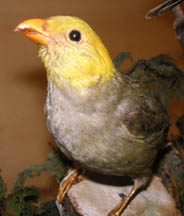‘Ō‘ū

ʻŌʻū. PC: Bishop Museum
Names
- ʻŌlelo Hawaiʻi: ‘Ō‘ū
- Scientific: Psittirostra psittacea
Conservation Status
- Presumed Extinct
- Federally Listed as Endangered
- State Listed as Endangered
- State Recognized as Endemic
- NatureServe Heritage Rank G1—Critically Imperiled
- IUCN Red List Ranking—Critically Endangered (Possibly Extinct)
- Revised Recovery Plan for Hawaiian Forest Birds—USFWS 2006
Species Information
The ‘ō‘ū is a heavy-bodied Hawaiian honeycreeper (family: Fringillidae) with a distinctive thick, pink, parrot-like bill. Adults are olive-green with whitish undertail coverts; males have a bright yellow head. Early naturalist noted that ‘ō‘ū had a strong musky odor, which is retained in museum specimens. Like several of Hawaii’s nectivorous birds, ‘ō‘ū are strong fliers and ranged widely in search of fruit. ‘Ie‘ie (Freycinetia arborea) flowers apparently are an important part of the species’ diet, although ‘ō‘ū also feed on the fruits of Clermontia spp. as well as other native fruits. Geometrid caterpillars are an important food item during the breeding season. Little is known of the species life history and its nesting and breeding habits have not been described.
Distribution
Possibly extinct. Occupied forests between 900 and 1,500 meter (3,000 and 5,000 feet, respectively) elevations on the islands of Kaua‘i and Hawai‘i. Historically widespread, ‘ō‘ū formerly occurred on all the Main Hawaiian Islands in low- to high elevation forests. They are now presumed extirpated on every island except possibly on Kaua‘i and Hawai‘i.
Habitat
Although known from a range of forest types, all recent observations have occurred in mid-elevation mesic to wet ‘ōhi‘a (Metrosideros polymorpha) forests with an understory of ‘ie‘ie (Freycinetia arborea), tree ferns (Cibotium spp.), ‘ōlapa (Cheirodendron spp.), kāwa‘u (Ilex anomala), kolea (Myrsine spp.), and pilo (Coprosma spp.). All recent sighting of ‘ō‘ū have occurred on lands managed by the State of Hawai‘i.
Threats
- Habitat degradation. Pigs (Sus scrofa) degrade the understory of wet forest destroying food plants.
- Disease. ‘Ō‘ū primarily occurred in low- to mid-elevation forests where the effects of mosquito-borne diseases was most severe. The species’ foraging movements may have increased their exposure to disease.
- Predation. In addition to potentially depredating nests, rats (Rattus spp.) may also compete with ‘ō‘ū by reducing the availability of fruits.
- Natural disasters. In 1984, a large portion of the Upper Waiākea Forest Reserve was inundated by a lava flow from Mauna Loa. This flow occurred in an area where the most recent observations of the species were noted and destroyed high quality ‘ō‘ū habitat. In 1982 and 1992, two strong hurricanes struck Kaua‘i, devastating native forest habitat. The ‘ō‘ū, has not been observed on Kaua‘i since 1992.
Additional Resources
For more information and references visit the DLNR State Wildlife Action Plan factsheets. DOFAWʻs species pages and State Wildlife Action Plan fact sheets are provided for general information and are not meant to be a citable, original source of data. If you are a student, researcher, or writer looking for a citable source, please explore the references below or find other original data sources, rather than citing these webpages. The references below were provided by the authors of the State Wildlife Action Plan fact sheets at the time of drafting:
- IUCN Red List of Threatened Species. 2015. Version 2014.3. Available at: www.iucnredlist.org. (Accessed May 2015).
- Scott JM, Mountainspring S, Ramsey FL, Kepler CB. 1986. Forest bird communities of the Hawaiian islands: their dynamics, ecology and conservation. Lawrence, (KS): Cooper Ornithological Society.
- Snetsinger TJ, Reynolds MH, Herrmann CM. 1998 ‘O’u (Psittirostra psittacea) and Lana’i hookbill (Dysmorodrepanis munroi). In The Birds of North America, No. 335-336 (Poole A, Gill F, editors.). Philadelphia, (PA): The Academy of Natural Sciences; and Washington DC: The American Ornithologists’ Union.
- U.S. Fish and Wildlife Service. 2006. Revised Recovery plan for Hawaiian forest birds. Portland, (OR): U.S. Fish and Wildlife Service
